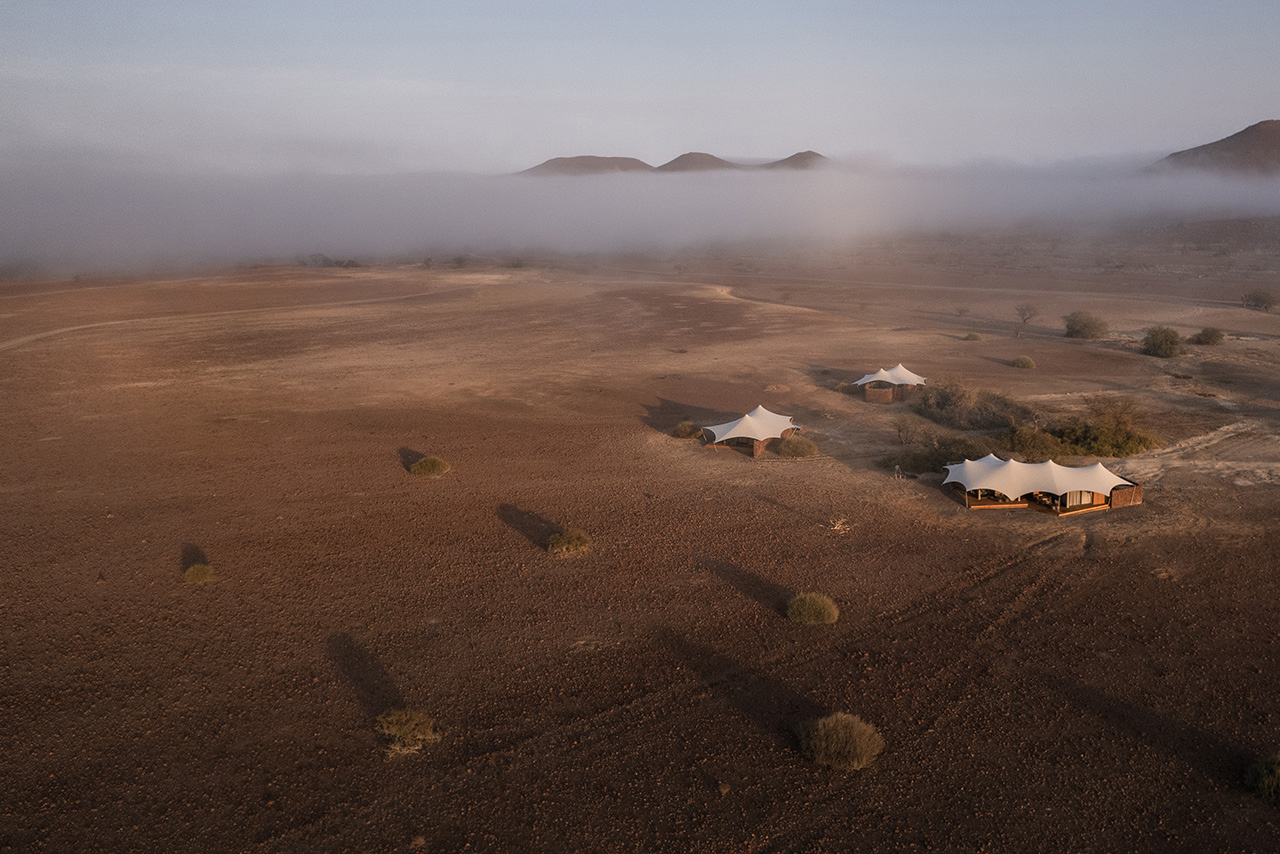The journey starts at Windhoek International Airport at 10:30 or 15:50. If your international flight arrives late in the afternoon, you need to spend a first night in Windhoek.
The safari ends at Windhoek International Airport at around 3pm. Should you require an earlier arrival in Windhoek for your international flight, we can book an earlier flight at a higher price.
On this fly-in safari you spend four nights in the Namib Desert to experience the towering sand dunes of Sossusvlei and the gently rolling dunes of Wolwedans. You then fly over the Namib, along the coast via Swakopmund straight to the rugged Damaraland, where you will be part of a rhino tracking experience at Desert Rhino Camp. Hoanib Skeleton Camp, your next camp, is located in the wild and remote Kaokoveld. The Hoanib River attracts all kinds of desert wildlife such as desert adapted elephants, lions, cheetah, brown hyena, giraffe, oryx and more. From here you will be able to do a day trip down to the Skeleton Coast and visit the seals and the area around Moewe Bay, a truly unique excursion. To complete your journey to Namibia, Etosha National Park and the private Ongava Reserve, Namibia's prime wildlife destinations await.
Little Kulala offers eleven climate-controlled rooms (it's very hot in the Namib region from November onwards!) with en-suite facilities, extra outdoor shower, private plunge pool, veranda with outdoor lounge, and a skybed where guests can spend a romantic night under the clear, starry sky.
The camp places great emphasis on natural materials, and the colours of the linen, cotton and mohair fabrics blend seamlessly into the natural surroundings. The Kulala Camps stand out for their fantastic location close to the Sossuvlei dunes and with exclusive access to the park.
Sossusvlei is the area most associated with Namibia: Red dunes as far as the eye can see (up to 380 m high, coloured red by the clay-rich sand) and dead trees in the Vleis or pans, decaying slowly at the will of the arid climate. The Vleis were created by the Tsauchab River, which probably once flowed to the Atlantic some 50 km away. The whole Sossusvlei region is quenched with water during those very rare years when a good amount of rain falls, prompting bushes and flowers to spring up everywhere.
On landing (wherever the wind has taken you) there is a champagne breakfast waiting for you.
Positioned on the edge of a 250-metre high dune, Wolwedans Dune Camp offers six rooms and a family suite (Dune Camp Private). Guests stay in very comfortable tents, which are pitched on wooden platforms. A spacious deck, allowing for safe sleep-outs under the stars and a private bathroom (insider & outside) make for a rather civilized camping experience. Each room comes with the ‘Wolwedans Chiller’ – a water-filled silo to cool off during hot summer months.
Dune Camp Private is your private option at Dune Camp, offering space for 4 adults & 2 children, and sold on exclusive basis only. It sits high on a dune, withing walking distance from Dune Camp, but far away for total privacy. The villa has two bedrooms connected by a living area and a large deck, providing space to relax but also plenty of privacy. Each bedroom has an en-suite bathroom and a ‘Wolwedans Chiller.’
Wolwedans Collection offers three further accommodation possibilities:
Read more about Wolwedans Desert Lodge
Read more about Wolwedans Plains Camp
Read more about Wolwedans Boulders
Desert Rhino Camp was created in collaboration with the ‘Save the Rhino Trust', an organisation dedicated to saving black rhino. These wonderful creatures have been widely protected from poaching and the rhino population in this area is the largest in Africa outside a national park! The partnership between the local communities, Save the Rhino Trust Namibia (SRT) and Wilderness ensures that Desert Rhino Camp remains one of the best places to see these imperilled animals in their pristine natural habitat.
Wilderness Desert Rhino Camp creates a sheltered haven within the occasionally harsh but always stunning desert environment. All six tents face the rugged desert landscape, featuring deep overhanging stretch fabric roof structures that offer protection from the desert sun while preserving the exquisite horizon views, within this breathtaking desert landscape. Soft interiors showcase stone, timber and leather, celebrating the classic explorer age, while seamlessly blending in modern style and sophistication. Each of the suites has its own stargazing deck, inviting quiet contemplation under the bountiful African sky.
Families are easily accommodated in the family tent consiting of two identical units, each with its own en-suite facilities. The family rooms sleeps four comfortably.
Access is either by air or visitors can leave their own vehicle at Palmwag Lodge and use the shuttle service for the 1-hour journey to camp.
The exclusive Hoanib Skeleton Coast camp compromises just eight twin-bedded tents and one family unit. The tents are raised on platforms and include a private shaded outdoor lounge.
The central part of the camp compromises a big tent with bar, lounge, library and dining area. A second lounge and the swimmingpool area are located on either side of the main building. The fire pit in front of camp is the meeting point for pre-dinner drinks and early breakfasts.
The camp has views north towards the Hoanib river and is flanked east and west by rugged hills. The camp looks out onto a small waterhole that is often visited by elephant, oryx and other mammals.
Hoanib Skeleton Coast Camp is located on a private concession available only to the guests of the lodge. This huge area includes the Hoanib riverbed and its banks from Amspoort down to the ocean. Only guests of Hoanib Skeleton Coast Camp are allowed to use this area on scenic drives and excursions.
The Hoanib river remains dry for most time of the year. However, once the first rains fall, usually not before November, the Hoanib can temporarily turn into a wild river.
Andersson's Camp is situated in the private Ongava Reserve close to Etosha National Park. The camp offers a very private safari experience with only seven double rooms and one family room. All rooms have en-suite bathrooms, indoor and outdoor shower, air-conditioning and a private viewing deck with 180 degree panorama. The family room consits of two suites (each with it's own bathroom and entrance) that are linked by a short walkway.
The main building features great views of the waterhole in front of camp. Guests can watch the animals from the spacious and comfortable lounge. Should you wish to get even closer, a photographic hide not far from camp offers a water level view of the prolific wild and birdlife. There is also a library, a curio shop, a beautiful infinity pool and a photo lounge, where you can check your own photos and send them to friends (Wi-Fi available).
A highlight of Andersson's Camp is the Ongava Research Centre. Researchers and scientists have their working space here and you are invited to visit the exhibition area and attend the interactive presentations in the auditorium.
Ongava Tented Camp, Little Ongava and Ongava Lodge are also situated in the Ongava Game Reserve.
The Etosha National Park is one of the most important nature reserves in southern Africa. It exists since 1907 and covers an area of 22,270 km². The central and eastern sections consist mainly of various silvery-white shining salt pans, which have made Etosha famous. In the dry season the park, the animals and the vehicles are covered in a whitish haze of salt dust.
On the southern shore of the huge Etosha Pan (130 x 50 km) there are several waterholes, which magically attract the animals from the surrounding area during the dry season. The three large state camps Okaukuejo, Halali and Namutoni connect Anderson's Gate in the south with the von Lindequist Gate in the east. The western part towards Galton Gate is much more wooded and less frequented by visitors, but it also offers less trails to drive around and find wildlife.
Etosha National Park is Namibia's premier safari destination. Covering almost the same area as Switzerland, Etosha is one of the largest national parks in Africa. To the west of the park lay the silvery white salt pans and adjoining waterholes, which magically attract all kinds of wildlife during the dry season.
Basic Information
Individual journey. The journey will be planned on your preferred dates.
Duration 12 nights. Minimum age 6 years. Weight limit of luggage 20 kg.
Includes all transfers from Windhoek to the hotels/camps to Windhoek
- Little Kulala: Double Room. All meals, drinks (except premier brands), laundry service, twice daily shared activities with one of the camp guides. Includes guided excursion to the dunes of Sossusvlei and scenic balloon flight.
- Wolwedans Dune Camp: Double Room. All meals, drinks (except premier brands), twice daily shared activities with one of the camp guides.
- Desert Rhino Camp: Double Room. All meals, drinks (except premier brands), laundry service, twice daily shared activities with one of the camp guides.
- Hoanib Skeleton Coast Camp: Double Room. All meals, drinks (except premier brands), laundry service, twice daily shared activities with one of the camp guides. Includes day trip to the skeleton coast / Moewe Bay.
- Andersson's Camp: Double Room. All meals, drinks (except premier brands), laundry service, twice daily shared activities with one of the camp guides.
Learn more about these areas

















